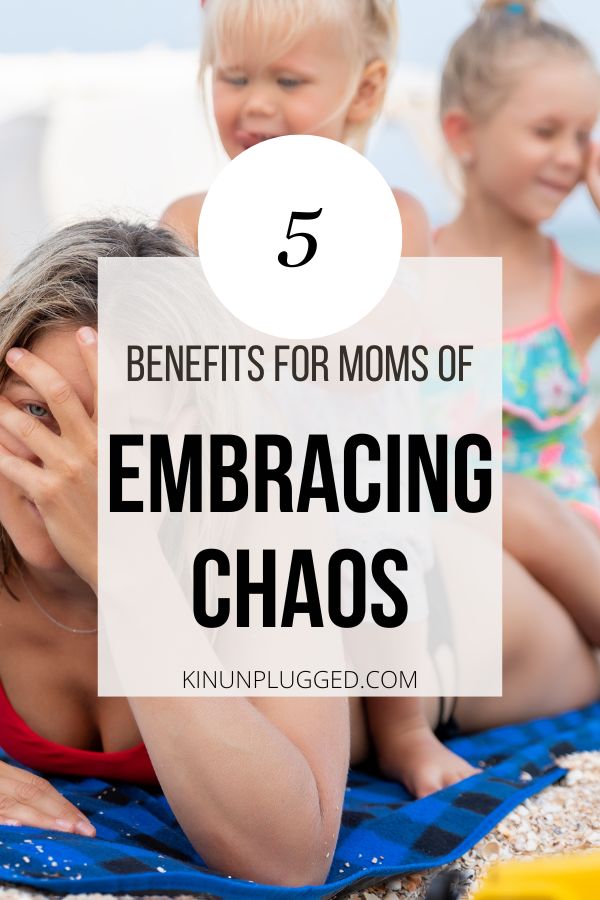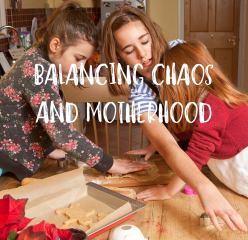I know this might sound a little crazy but hear me out: moms need to allow at least three hours of complete chaos each day.
Understanding the challenges faced by moms allows us to offer empathy, support, and resources to help alleviate their burdens. It promotes mental and emotional well-being, contributes to gender equality, informs parenting practices, and helps create inclusive communities where all moms feel supported and valued.
Moms need 3 hours of allowing complete chaos to maintain their mental well-being and balance their responsibilities effectively.
The role and responsibilities of moms

Roles of moms in society have changed quite a lot over time.
Traditional Roles of Moms in Society
- Caregiver
Historically, moms have been primarily responsible for nurturing and raising children, providing emotional support, and meeting their daily needs.
- Homemaker
Moms often assume the role of managing household chores, including cooking, cleaning, and organizing, to create a comfortable and nurturing environment for the family.
- Family Coordinator
Moms have traditionally played a central role in organizing family activities, scheduling appointments, and coordinating family events and celebrations.
- Emotional Support
Moms are often seen as the emotional pillars of the family, providing comfort, guidance, and a listening ear to family members.
- Educator
Mothers have been instrumental in teaching and instilling values, manners, and life skills in their children, passing down cultural traditions and knowledge.
Modern Roles of Moms in Society
- Dual-Career Balancer
In contemporary society, many moms pursue careers outside the home while also managing their familial responsibilities. They navigate the challenges of balancing work and family life.
- Breadwinner
With the evolving dynamics of gender roles and economic demands, many moms are the primary or equal earners in their households, taking on the role of financial provider for their families.
- Co-parent
Modern moms often share parenting responsibilities and decision-making with their partners, working as a team to raise their children.
- Advocate for Children
Moms today actively advocate for their children’s education, healthcare, and overall well-being, ensuring they have access to quality resources and opportunities.
- Entrepreneur
An increasing number of moms are pursuing entrepreneurial ventures, starting businesses, and embracing innovative work arrangements that allow flexibility and fulfillment in their careers.
The various responsibilities that moms typically juggle
Moms often juggle multiple responsibilities simultaneously, which can vary depending on individual circumstances, cultural factors, and personal choices.
Moms are responsible for the day-to-day care and upbringing of their children, which includes feeding, bathing, dressing, helping with homework, attending to medical needs, nurturing emotional well-being, and fostering their overall development.
Many moms also take on the role of managing household tasks, such as grocery shopping, meal planning and preparation, cleaning, laundry, and home organization. They ensure that the household runs smoothly and efficiently.
A significant number of moms also pursue careers or work outside the home, balancing their professional responsibilities with their parenting duties. This includes managing work schedules, attending meetings, completing assignments, and sometimes dealing with work-related travel.
Moms often engage in social and community activities, such as participating in parent-teacher associations, volunteering, attending social events, and supporting local organizations or causes.
Moms often engage in a delicate balancing act, adapting and adjusting their responsibilities as needed to meet the ever-changing demands of their families and personal lives.
There is a constant demand for a mom’s time and attention.
What does “allowing complete chaos” mean?
Allowing complete chaos in the context of this article means stopping yourself from establishing, maintaining or restoring order but does not apply in life threatening situations. Allowing complete chaos does not mean completely abandoning responsibility.
5 Benefits of embracing chaos as a mom

While embracing chaos as a mom may seem counter-intuitive, there can be some potential benefits for moms in doing so.
- Adaptability and Resilience
Embracing chaos as a mom can help develop adaptability and resilience. Motherhood often presents unexpected challenges, and being open to embracing the unknown can help moms navigate these situations with greater flexibility and less stress. It allows them to quickly adjust their plans and find creative solutions when faced with unexpected circumstances.
- Growth and Personal Development
Embracing chaos as a mom can be an opportunity for personal growth and self-discovery. It encourages moms to step outside their comfort zones, think on their feet, and explore new ways of doing things. By embracing unpredictability, moms can develop new skills, learn from their experiences, and become more confident in their ability to handle diverse situations.
- Building Stronger Relationships
Chaos and unpredictability can provide opportunities for bonding and building stronger relationships. When faced with challenges together, families often come closer and develop a sense of unity. Moms who embrace chaos and uncertainty can create a supportive and nurturing environment for their loved ones, fostering resilience and deeper connections within the family.
- Letting Go of Perfectionism
Embracing chaos as a mom can help you to let go of the need for perfectionism. Trying to control every aspect of motherhood can be exhausting and overwhelming. Embracing unpredictability allows moms to accept that not everything will go according to plan and that it’s okay to have imperfections. It promotes self-compassion and encourages moms to focus on the bigger picture rather than getting caught up in minor setbacks.
- Spontaneity and Fun
Embracing chaos as a mom can bring an element of spontaneity and fun to motherhood. It opens the door to unexpected adventures, surprising moments, and the joy of spontaneity. By embracing the unpredictable nature of parenting, moms can cultivate a sense of playfulness and find pleasure in the unexpected moments.
The importance of flexibility in managing a household

Life is full of unexpected events, challenges, and transitions. Flexibility allows households to adapt and adjust to these changes. Whether it’s a sudden schedule change, a family member’s illness, or a new opportunity, being flexible enables households to navigate these situations with greater ease and less stress.
Flexibility promotes efficient problem-solving. When unexpected situations arise, being flexible allows household members to think creatively, consider alternative solutions, and adapt their plans accordingly. It helps in finding quick and effective resolutions to challenges that arise in managing a household.
Different family members may have diverse needs, preferences, and schedules. Being flexible and open to compromise helps accommodate these individual differences and promotes a sense of fairness, respect, and understanding among family members. It allows for collaboration and reduces conflicts that may arise due to rigid expectations.
Flexibility is crucial for achieving a healthy work-life balance. Household responsibilities often need to be balanced with professional commitments, personal interests, and self-care. Being flexible in managing household tasks allows individuals to allocate time and energy appropriately, ensuring that all aspects of life receive attention and consideration.
Life is filled with unexpected events, such as emergencies, family crises, or sudden changes in circumstances. Flexibility enables households to cope with these events by adjusting routines, reallocating resources, and providing support to family members in need. It helps in maintaining stability and minimizing disruptions during challenging times.
Flexibility in managing a household encourages independence and responsibility among family members. By allowing individuals to take ownership of specific tasks and make decisions within their realms, flexibility empowers them to develop life skills, problem-solving abilities, and a sense of accountability.
Flexibility sets a positive example for children. Children learn and grow by observing their parents and caregivers. When they witness flexibility in action, they understand the importance of adapting to change, managing challenges, and approaching situations with an open mind. It cultivates resilience and equips them with valuable life skills.
The pressures of societal expectations and the myth of “perfect motherhood”

The societal myth of perfect motherhood is the unrealistic expectation imposed on mothers by society. It portrays motherhood as an idealized and flawless role, perpetuating the notion that mothers should effortlessly meet high standards of perfection in all aspects of their lives.
The problem is that this myth fails to acknowledge the complexities, challenges, and diversity of real motherhood experiences.
Here are some key aspects of the societal myth of perfect motherhood:
- Unattainable Standards: The myth suggests that mothers should excel in every area, including parenting, household management, self-care, and career, without any room for mistakes or shortcomings. This unrealistic expectation sets up mothers for constant feelings of inadequacy and self-doubt, as it is impossible to meet such unattainable standards consistently.
- Comparison and Judgment: The myth of perfect motherhood fuels comparison and judgment among mothers. When mothers believe that others are meeting the standards of perfection, they may feel inadequate or guilty for not measuring up. This can lead to unhealthy competition, criticism, and a lack of support among mothers.
- Sacrifice and Self-Neglect: The myth often portrays the ideal mother as selfless, dedicating all her time, energy, and resources solely to her children and family. It downplays the importance of self-care and personal fulfillment, creating an expectation that mothers should sacrifice their own needs and desires for the sake of their children.
- Gender Stereotypes: The myth reinforces traditional gender roles, placing the burden of perfection solely on mothers. It overlooks the roles and responsibilities of fathers and other caregivers, perpetuating the notion that motherhood is the primary determinant of a child’s well-being.
- Unrealistic Portrayals in Media: Media often perpetuates the myth of perfect motherhood through idealized and edited portrayals of mothers. These portrayals tend to showcase mothers who effortlessly balance all aspects of their lives, maintaining flawlessly tidy homes, and having well-behaved children. Such representations can create feelings of inadequacy and undermine the diverse realities of motherhood.
READ: 13 Quick & Easy Tips for when you are combating mom fatigue
RELATED: How to create the perfect self-care day routine (International Self-care Day)

How chaos can foster creativity, problem-solving, and resilience
- Encouraging Out-of-the-Box Thinking: Chaos disrupts the usual order and routines, forcing individuals to think outside the box and explore alternative solutions. When faced with chaotic situations, the usual strategies may not work, prompting individuals to tap into their creativity and come up with innovative approaches to problem-solving.
- Promoting Adaptability and Flexibility: Chaos often requires individuals to adapt quickly to changing circumstances. This cultivates adaptability and flexibility, as individuals learn to adjust their plans, think on their feet, and make decisions in unpredictable situations. This adaptability extends to problem-solving, enabling individuals to be more open-minded and willing to explore unconventional ideas or methods.
- Building Resilience: Dealing with chaos challenges individuals to bounce back from unexpected setbacks or disruptions. It tests their resilience and ability to persevere in the face of uncertainty and adversity. Over time, navigating chaotic situations strengthens resilience, allowing individuals to develop a mindset that embraces challenges as opportunities for growth and learning.
- Fostering Creative Problem-Solving: Chaos often requires individuals to think creatively and find innovative solutions. When traditional approaches fail or are insufficient, individuals are compelled to explore new ideas, consider multiple perspectives, and connect seemingly unrelated concepts. This process of creative problem-solving is stimulated by the need to adapt and navigate through chaos effectively.
- Encouraging Resourcefulness: Chaos often presents limited or unconventional resources. In such situations, individuals must tap into their resourcefulness, making the most of what is available to them. This fosters a mindset of finding creative alternatives, re-purposing existing resources, and maximizing their potential to solve problems efficiently.
- Providing Learning Opportunities: Chaos can be a valuable learning experience. It exposes individuals to unfamiliar situations, introduces new challenges, and provides opportunities for personal growth. Navigating through chaos allows individuals to develop new skills, broaden their knowledge, and gain insights that can be applied to future problem-solving scenarios.
- Building Confidence: Successfully navigating chaotic situations and overcoming challenges can boost individuals’ confidence and self-belief. Each time they find solutions amidst chaos, their confidence in their problem-solving abilities grows. This confidence contributes to increased resilience, adaptability, and creative thinking in future situations.
Embracing chaos as a mom can relieve stress and promote a sense of freedom
Embracing chaos as a mom means accepting that not everything can be controlled or perfect.
This mindset helps individuals let go of rigid expectations and outcomes, leading to reduced stress and a sense of freedom from constantly trying to meet unrealistic standards.
Embracing the unknown allows for the possibility of new experiences, growth, and discovery.
Chaos can bring moments of spontaneity and surprise.
It encourages people to tune into their intuition and make choices that align with their values and desires. This authenticity brings a sense of freedom, as people are liberated from the pressure to conform to external standards.
Your 7 strategies for implementing 3 hours of chaos
- Schedule Unstructured Time
Set aside specific blocks of time in your schedule for unstructured activities. This can be a designated “free play” time for your children or time for you to engage in spontaneous activities or pursue creative endeavors. Avoid over-scheduling during these periods to allow for flexibility and exploration.
- Embrace Messy Play
Designate specific times or areas where your children can engage in messy play, such as sensory activities, arts and crafts, or outdoor exploration. This allows them to freely explore and create without worrying about making a mess. Embrace the chaos and enjoy the creative process.
- Plan Surprise Adventures
Incorporate surprise adventures or spontaneous outings into your routine. It could be a last-minute trip to the park, a picnic, or a visit to a local attraction. These spontaneous experiences inject excitement and variety into your day, breaking up the routine and embracing the unpredictability of life.
- Create Theme Days
Designate specific days of the week for themed activities or challenges. For example, you could have a “Science Experiment Day,” a “Messy Art Day,” or a “Random Acts of Kindness Day.” These themed days introduce elements of chaos and fun into your routine, fostering creativity and exploration.
- Embrace Unplanned Moments
Allow yourself to be flexible and open to unanticipated moments of chaos in your daily routine. Instead of trying to control or avoid disruptions, embrace them as opportunities for spontaneity and adventure. Find joy in unexpected moments and adapt your plans accordingly.
- Prioritize Self-Care
Allocate time for your own self-care and personal interests. Engaging in activities that bring you joy, whether it’s reading, exercising, or pursuing a hobby, can help you embrace chaos in a different context. It provides an opportunity to let go of control and immerse yourself in the present moment.
- Engage in Playful Parenting
Embrace playful interactions with your children. Let go of rigid rules and routines during designated playtime, allowing for more spontaneous and imaginative play. Follow your children’s lead and engage in activities that promote laughter, joy, and shared experiences.
7 Ways to create a safe space for chaos and experimentation
While embracing chaos as a mom can bring spontaneity and a sense of freedom, it is crucial to prioritize the safety and well-being of yourself and your children. Here are some important considerations to ensure safety while allowing chaos:
- Childproofing: Create a safe environment for your children by childproofing your home. Secure potential hazards, such as sharp objects, chemicals, or unstable furniture. Use safety gates, outlet covers, and cabinet locks to prevent accidents. Regularly assess and update childproofing measures as your children grow and explore new areas.
- Supervision: Maintain appropriate supervision, especially during chaotic activities or when engaging in unstructured play. Keep a watchful eye on your children to ensure their safety, intervene when necessary, and prevent accidents or injuries.
- Age-Appropriate Activities: Consider the age and developmental stage of your children when planning chaotic activities. Ensure that the activities you choose are suitable and safe for their capabilities. Avoid activities that may pose significant risks or exceed their physical or cognitive abilities.
- Risk Assessment: Conduct a risk assessment before engaging in chaotic activities. Evaluate potential risks and take necessary precautions to minimize them. Consider factors such as the environment, equipment, and the behavior of your children to make informed decisions that prioritize safety.
- Communication and Boundaries: Establish clear communication with your children about safety rules and boundaries. Teach them about potential risks, how to navigate them, and the importance of following safety guidelines. Encourage open dialogue and address any concerns or questions they may have.
- Personal Safety: As a mom, prioritize your own safety as well. Take precautions to prevent injuries or accidents while engaging in chaotic activities. This includes being mindful of your own physical and mental well-being, setting boundaries, and seeking help or support when needed.
- Emergency Preparedness: Be prepared for unforeseen situations by having basic first aid supplies readily available. Familiarize yourself with emergency procedures and contact information for medical professionals or emergency services. Stay informed about safety guidelines and recommendations specific to your location or activities.
By intentionally setting aside time for chaos, you can infuse your life with spontaneity, creativity, and a sense of adventure.
Do you set daily time aside for allowing complete chaos as a mom?





